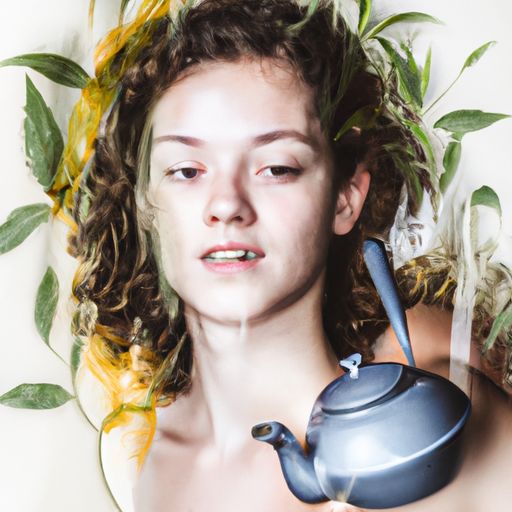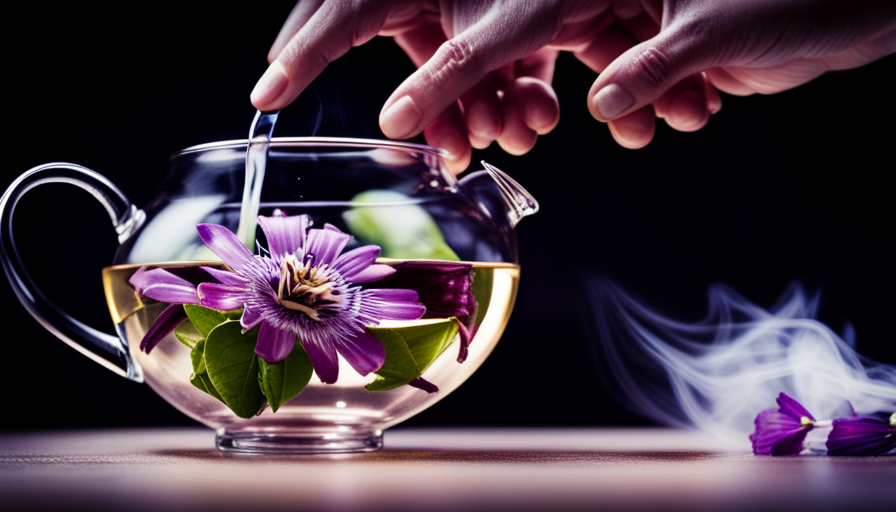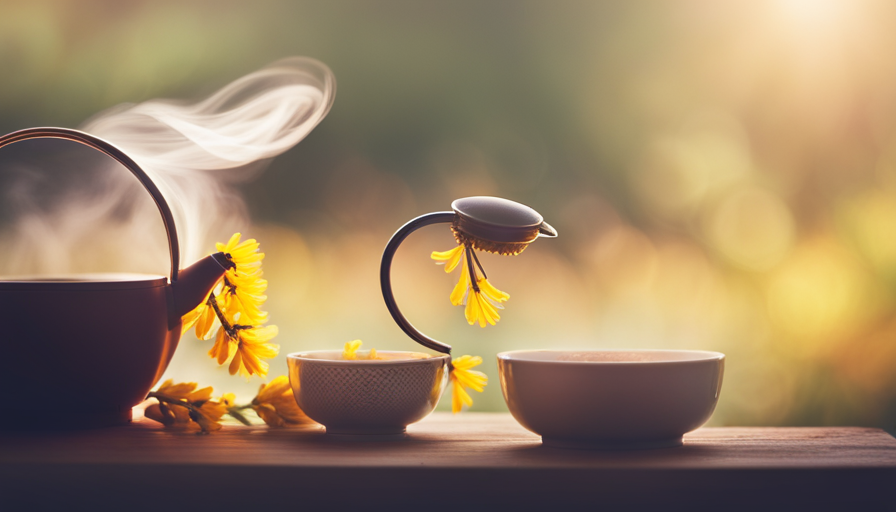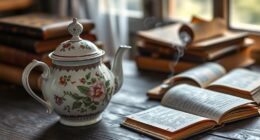The popular saying goes, ‘A flower doesn’t compare itself to the flower next to it, it just blooms.’ This holds true for flower tea, which offers a variety of flavors, scents, and health advantages.
Flower tea, also known as herbal tea or tisane, is a beverage made by infusing dried flowers in hot water. It is a centuries-old tradition that has been admired for its natural beauty and therapeutic properties.
To create flower tea, various flowers such as chamomile, hibiscus, lavender, and rose are carefully selected and dried to preserve their delicate flavors and essential oils. These flowers are then steeped in hot water, allowing their unique characteristics to be released, resulting in a fragrant and visually appealing infusion.
Not only is flower tea a delightful sensory experience, but it also offers numerous health benefits. From calming properties to aiding digestion and boosting the immune system, flower tea is a natural and refreshing way to enhance overall well-being.
In this article, we will delve into the fascinating world of flower tea, exploring its origins, how it is made, popular types, flavor profiles, and cultural traditions. So, let us embark on a journey of discovery and savor the beauty and benefits of flower tea.
Key Takeaways
- Flower tea is a centuries-old tradition admired for its natural beauty and therapeutic properties.
- Popular types of flower tea include jasmine, rose, and chamomile.
- Flower tea offers calming properties, aids digestion, and boosts the immune system.
- Flower tea should be steeped for 3-5 minutes to avoid bitterness.
Overview of Flower Tea
So, you’re probably wondering what flower tea is all about. Well, let me tell you, flower tea is a delightful concoction made by infusing various flowers into hot water, resulting in a fragrant and visually stunning beverage.
Not only is flower tea a treat for the senses, but it also offers numerous health benefits. Many flowers used in tea, such as chamomile and lavender, have calming properties that can help reduce stress and promote relaxation. Others, like hibiscus and rose, are rich in antioxidants that can boost the immune system and protect against chronic diseases.
When it comes to brewing flower tea, there are a few techniques to consider. For delicate flowers like jasmine, it’s best to use water that’s around 80°C to preserve their delicate flavors. On the other hand, hardy flowers like hibiscus can be brewed with boiling water for a stronger infusion. It’s also important to note that flower teas should be steeped for a shorter period compared to traditional tea, usually around 3-5 minutes, to avoid a bitter taste.
Now that you have an understanding of the benefits and brewing techniques of flower tea, let’s move on to how this captivating beverage is made.
How Flower Tea is Made
To create this delightful beverage, blossoms are carefully selected and infused with hot water, resulting in a fragrant and refreshing drink. The history of flower tea dates back thousands of years, originating in ancient China where it was enjoyed for its medicinal properties. Today, flower tea is consumed worldwide for its unique flavors and health benefits.
There are various varieties of flower tea, each offering its own distinct taste and aroma. Some popular options include jasmine tea, rose tea, and chamomile tea. Jasmine tea is made by combining green tea leaves with jasmine blossoms, resulting in a subtle floral flavor. Rose tea, on the other hand, is made using dried rose petals, providing a sweet and soothing taste. Chamomile tea, known for its calming properties, is made from the dried flowers of the chamomile plant.
To further understand the diversity of flower tea, let’s take a look at the table below:
| Variety of Flower Tea | Flavor Profile | Health Benefits |
|---|---|---|
| Jasmine Tea | Subtle floral | Antioxidant-rich, aids digestion |
| Rose Tea | Sweet and soothing | Rich in vitamin C, promotes skin health |
| Chamomile Tea | Calming | Relieves anxiety, aids sleep |
As we transition into the next section about the health benefits of flower tea, it is important to note that these teas not only offer delightful flavors but also provide numerous advantages for our well-being.
Health Benefits of Flower Tea
Indulging in a cup of these exquisite floral infusions can not only tantalize your taste buds but also offer a wide array of health benefits. Flower tea, made from various flowers such as chamomile, hibiscus, and lavender, has long been used in herbal remedies and relaxation techniques.
Here are three reasons why incorporating flower tea into your daily routine can be beneficial:
-
Stress relief: Flower teas like chamomile and lavender are known for their calming properties. They can help reduce anxiety, promote relaxation, and improve sleep quality. Sipping on a warm cup of flower tea after a long day can be a soothing ritual that helps you unwind.
-
Digestive aid: Some flower teas, like hibiscus, can aid in digestion. They have been shown to help alleviate stomach cramps, bloating, and indigestion. Additionally, certain flower teas have anti-inflammatory properties that can soothe the digestive system.
-
Immune support: Flowers such as elderflower and rosehip are rich in antioxidants, which can help boost the immune system and protect against oxidative stress. Regular consumption of flower tea may help strengthen your body’s defense mechanisms.
Transitioning into the subsequent section about popular types of flower tea, it’s fascinating to explore the specific benefits and flavors that each type offers.
Popular Types of Flower Tea
One cannot resist the allure of the delightful flavors and therapeutic benefits that popular types of flower tea provide. Flower tea comes in a variety of flavors, each with its own unique taste and aroma. Some of the most popular types include chamomile, rose, lavender, hibiscus, and jasmine.
To fully enjoy the flavors of flower tea, it is important to use the correct brewing techniques. The brewing process can vary depending on the type of flower tea you are using. For example, chamomile tea is best brewed with water that is just below boiling temperature, while lavender tea requires hot but not boiling water. Hibiscus tea, on the other hand, is steeped in boiling water for several minutes to bring out its vibrant flavor.
To engage the audience further, here is a table showcasing the different flavors and brewing techniques of popular flower teas:
| Flower Tea | Flavor Profile | Brewing Technique |
|---|---|---|
| Chamomile | Delicate, floral | Water just below boiling temperature |
| Rose | Fragrant, sweet | Boiling water, steep for 5-7 minutes |
| Lavender | Calming, herbal | Hot water, not boiling |
| Hibiscus | Tangy, tart | Boiling water, steep for 5-10 minutes |
| Jasmine | Floral, aromatic | Water just below boiling temperature |
With their wide range of flavors and brewing techniques, flower teas offer a delightful experience for the senses. In the next section, we will explore the flavor profiles of flower tea in more detail.
Flavor Profiles of Flower Tea
Let’s dive into the delightful flavors that flower tea has to offer. Flower teas come in a wide range of flavors, each offering a unique sensory experience.
Here are some popular types of flower teas and their flavor profiles:
-
Chamomile: Known for its calming properties, chamomile tea has a delicate, floral taste with hints of apple and a subtle sweetness.
-
Rose: With its romantic aroma, rose tea has a gentle, floral flavor that’s slightly sweet and soothing to the palate.
-
Lavender: Lavender tea is known for its relaxing effects. It has a fragrant, floral taste with a hint of sweetness and a subtle earthiness.
These different types of flower teas offer a variety of flavors that cater to different preferences. If you’re looking to unwind and relax, chamomile, rose, and lavender teas are highly recommended. Their soothing flavors can help alleviate stress and promote a sense of calmness.
Now that we’ve explored the flavor profiles of flower teas, let’s move on to the next section and discover some brewing tips that’ll enhance your tea-drinking experience.
Brewing Tips for Flower Tea
Enhance your experience with flower tea by following these brewing tips. Steeping flower tea requires a delicate touch to extract the flavors and aromas fully. Here are some tips for steeping flower tea to perfection:
-
Water Temperature: Use water that is just below boiling point, around 176°F (80°C). Boiling water can scorch the delicate petals and result in a bitter taste.
-
Steeping Time: The ideal steeping time for flower tea is typically between 3 to 5 minutes. However, this can vary depending on the type of flower tea you are brewing. Some flower teas may require a shorter steeping time, while others may need a bit longer.
-
Tea to Water Ratio: Use approximately 1 teaspoon of flower tea per cup of water. Adjust the amount according to your preference for a stronger or milder brew.
To give you a better understanding, here’s a table showcasing the recommended steeping times for popular flower teas:
| Flower Tea | Steeping Time |
|---|---|
| Jasmine | 3-4 minutes |
| Chamomile | 5 minutes |
| Rose | 3-5 minutes |
By following these tips for steeping flower tea, you can enjoy a delightful cup of floral goodness. The best time to savor flower tea is during a moment of relaxation or as a soothing bedtime drink. Now, let’s move on to the next section and explore how to serve and enjoy flower tea.
Serving and Enjoying Flower Tea
To truly savor the essence of a blooming garden, immerse yourself in the art of serving and enjoying the delicate flavors and fragrances of these floral infusions.
When it comes to serving flower tea, there are a few techniques that can enhance your experience. Firstly, it’s important to use transparent glass teaware, as it allows you to witness the mesmerizing dance of the blossoms as they unfurl in hot water. This not only adds visual appeal but also allows the delicate aromas to be released and enjoyed.
Secondly, for optimal taste, it’s recommended to use water at a temperature appropriate for the specific type of flower tea. White or green flower teas, for example, are best brewed at lower temperatures to preserve their delicate flavors.
Pairing options for flower tea are diverse and can be customized to suit your preferences. For a refreshing and light combination, try pairing a floral green tea with a slice of lemon or a sprig of mint. If you prefer a sweeter taste, a floral black tea can be enjoyed with a piece of dark chocolate or a small pastry. The possibilities are endless, so feel free to experiment and find your perfect pairing.
As we delve into exploring the cultural traditions surrounding flower tea, it’s important to understand the basic serving and pairing techniques.
Exploring Cultural Traditions
Immerse yourself in the rich tapestry of cultural traditions surrounding the art of enjoying and serving flower tea. These traditional practices have been passed down through generations, reflecting the deep respect and appreciation for the beauty and medicinal properties of flower teas. Here are four fascinating aspects of these cultural traditions:
-
Ritualistic Preparation: In many cultures, the process of preparing flower tea is seen as a sacred ritual. Delicate blossoms are carefully selected and steeped in hot water, allowing their flavors and aromas to infuse the liquid. This mindful preparation enhances the sensory experience of drinking flower tea.
-
Symbolic Significance: Flower teas often carry symbolic meanings in different cultures. For example, chrysanthemum tea is associated with longevity and is commonly served during special occasions or festivals. Lotus tea represents purity and is often enjoyed during meditation or spiritual practices.
-
Social Bonding: Serving flower tea is often seen as a way to connect with others. It’s a common practice to serve flower tea to guests as a gesture of hospitality and friendship. The act of sharing tea creates a sense of community and fosters meaningful conversations.
-
Medicinal Properties: Flower teas are not only pleasurable to drink but also offer various health benefits. Many flowers used in tea, such as chamomile and lavender, have calming properties that help reduce stress and promote relaxation. Other flowers, like hibiscus and rose, are rich in antioxidants and can aid in digestion.
Now, let’s delve into the next section and explore where to buy flower tea without missing a beat.
Where to Buy Flower Tea
Indulge in the enchanting world of blossoming flavors by exploring the hidden treasure troves where these delicate infusions can be found. Flower tea, with its mesmerizing aroma and exquisite taste, has gained popularity among tea enthusiasts for its unique qualities.
When it comes to purchasing flower tea, there are several options available. Local tea shops and specialty stores often carry a wide variety of flower teas, allowing you to sample different flavors and find your favorite. Online retailers also offer a convenient way to browse and purchase flower tea from the comfort of your own home.
Drinking flower tea has its pros and cons. On the positive side, flower tea is known for its health benefits. It’s rich in antioxidants, which can help boost the immune system and protect against free radicals. Flower tea also has a calming effect and can aid in relaxation. However, it’s important to note that some people may be allergic to certain types of flowers, so it’s advisable to consult with a healthcare professional before incorporating flower tea into your diet.
Aside from enjoying flower tea on its own, there are various ways to incorporate it into recipes. Flower tea can be used as a flavorful ingredient in baked goods, such as cakes and cookies. It can also be infused into syrups and used in cocktails or mocktails for a unique twist. Additionally, flower tea can be added to soups or sauces to impart a delicate floral essence.
The availability of flower tea in local stores and online retailers makes it easily accessible for tea lovers. Drinking flower tea has its benefits, but it’s important to be mindful of any potential allergies. Exploring different ways to use flower tea in recipes can add a touch of elegance and exotic flavors to your culinary creations.
Transitioning to the next section, let’s delve into the captivating world of flower tea brewing techniques.
Conclusion and Final Thoughts
In conclusion, when it comes to buying flower tea, there are a variety of options available. Whether you prefer to purchase it from a local tea shop, online retailers, or even grow your own flowers to make tea, the choice is yours. It is important to consider the quality and source of the flowers to ensure that you are getting a high-quality product. Additionally, reading reviews and doing research on the seller can help you make an informed decision.
Now, let’s delve into the fascinating world of flower tea and explore its history and significance in different cultures. Flower tea has been consumed for centuries and holds a special place in many traditions and rituals. Different cultures have their own unique ways of preparing and enjoying flower tea, each with its own symbolism and meaning.
However, it is worth noting that while flower tea offers many potential health benefits, there may also be some side effects or risks associated with its consumption. It is always important to consult with a healthcare professional before adding flower tea to your diet, especially if you have any underlying health conditions or are taking medications that may interact with the tea.
In the table below, I have summarized some discussion ideas about the history and significance of flower tea, as well as the potential side effects or risks of consuming it.
| Discussion Ideas: |
|---|
| The history of flower tea |
| Its significance in different cultures |
| Potential side effects or risks |
Frequently Asked Questions
How long does flower tea stay fresh?
Flower tea stays fresh for an extended period when stored properly. To maintain its freshness, store flower tea in an airtight container in a cool, dry place away from sunlight and strong odors. This will prevent moisture, heat, and light from degrading the tea’s quality. When stored correctly, flower tea can retain its flavor and aroma for up to two years.
Additionally, flower tea offers numerous benefits, such as promoting relaxation, boosting immunity, and providing antioxidants for overall well-being.
Can flower tea be consumed by pregnant women?
Yes, flower tea can be consumed by pregnant women. While there may be concerns about its effects on fetal development, studies have shown that flower tea is generally safe to consume during pregnancy. In fact, flower tea can provide potential benefits such as reducing nausea and improving digestion, which are common discomforts during pregnancy. However, it’s always advisable to consult with a healthcare professional before incorporating flower tea into your pregnancy diet.
Are there any side effects of drinking flower tea?
There are several health benefits of drinking flower tea, but it’s important to be aware of potential side effects. Different types of flower tea have unique flavors and offer specific advantages.
For instance, chamomile tea promotes relaxation and aids in digestion, while hibiscus tea is rich in antioxidants and can lower blood pressure. However, excessive consumption of flower tea can lead to allergic reactions or interact with certain medications.
It’s always advisable to consult with a healthcare professional before adding flower tea to your routine.
Can flower tea be used for weight loss?
Flower tea is a delightful option for weight loss as it offers numerous benefits for overall health. The various flavors and varieties of flower tea make it an enjoyable and effective tool for shedding those extra pounds. This natural beverage aids in boosting metabolism, reducing appetite, and promoting fat burning.
Moreover, flower tea is rich in antioxidants, vitamins, and minerals, which support a healthy lifestyle and contribute to weight management.
Is it possible to mix different types of flower tea together?
Yes, it’s possible to mix different types of flower tea together to create unique flavor combinations. By blending different flower teas, you can explore a wide range of tastes and aromas.
To maximize the taste and aroma of mixed flower tea varieties, it’s important to pay attention to brewing techniques. Each flower tea may have different brewing requirements, so experimenting with water temperature and steeping time is crucial. This will ensure that you achieve the perfect balance of flavors in your mixed flower tea.
Conclusion
In conclusion, flower tea isn’t just a beautiful beverage, but it’s also a powerhouse of health benefits. Some may argue that flower tea is merely a fad, but its long history and cultural significance can’t be denied. By incorporating flower tea into your daily routine, you can experience the unique flavors and aromas that’ll transport you to a world of tranquility.
So, next time you sip on a cup of flower tea, imagine yourself surrounded by vibrant blossoms, feeling a sense of calm and rejuvenation wash over you.










